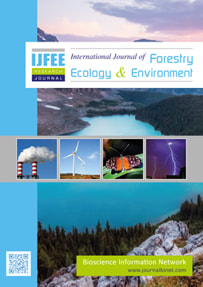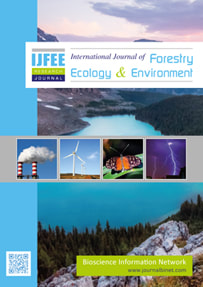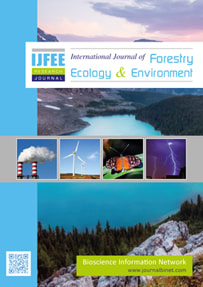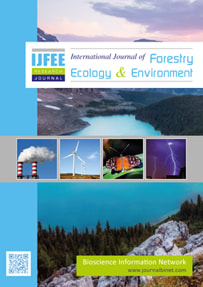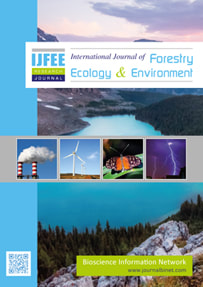International Journal of Forestry, Ecology & Environment
Volume 03 - Issue 01 | Year of Publication: 2021
Article Type: Research Article | No. 11, 2021 | Country: Philippines | pp. 100-113 | Open Access
Title: Carbon stock assessment through above-ground biomass of trees at different forest composition in Mt. Malindawag, Lubilan, Naawan, Misamis Oriental, Philippines
Authors: Origenes, M. G. and Lapitan, R. L.
DOI: https://doi.org/10.18801/ijfee.030121.11
Title: Carbon stock assessment through above-ground biomass of trees at different forest composition in Mt. Malindawag, Lubilan, Naawan, Misamis Oriental, Philippines
Authors: Origenes, M. G. and Lapitan, R. L.
DOI: https://doi.org/10.18801/ijfee.030121.11
Carbon stock assessment through above-ground biomass of trees at different forest composition in Mt. Malindawag, Lubilan, Naawan, Misamis Oriental, Philippines
Abstract
It is documented that the amounts of carbon stored and its level of degradation in different forests compositions and different types of forest is mostly unknown, Philippines is no exemption as little was done in some places of this country. This study was conducted to assess carbon stock through above ground biomass of trees at different forest composition in Mt. Malindawag. There were three (3) 20m x 20m sample plots (quadrats) (400m2 equivalent to 0.04 ha) established as replicate plots provided with 50m intervals. Forest composition such as the Agroforestry area, mixed forest area and the Plantation forest were assessed in terms of the number of individuals, number of species, diameter, and height to calculate the biomass, tree biomass density as well as the carbon stock. Based on the results of the study conducted in different forest compositions of Mt. Malindawag, plantation forest has the highest carbon stocking rate. However, these results were not significantly different from the other forest composition. This was associated with a higher accumulated diameter, which resulted in higher biomass and eventually carbon stock. Species found in this forest composition are productive and have lesser number of individuals; therefore, there is lesser competition for resources such as light. Such a mechanism might contribute to the higher biomass and carbon stock. However, the result may not be right to other areas due to uncontrollable factors, anthropogenic and environmental factors. Hence, it is recommended to have further studies on areas where trees have similar age, species diversity index as well as stand development and site productivity for a more accurate and quantifiable carbon stock.
Key Words: Carbon storage, Forest composition, Agroforestry, Mixed forest, Plantation forest, Tree biomass and Species diversity index.
Abstract
It is documented that the amounts of carbon stored and its level of degradation in different forests compositions and different types of forest is mostly unknown, Philippines is no exemption as little was done in some places of this country. This study was conducted to assess carbon stock through above ground biomass of trees at different forest composition in Mt. Malindawag. There were three (3) 20m x 20m sample plots (quadrats) (400m2 equivalent to 0.04 ha) established as replicate plots provided with 50m intervals. Forest composition such as the Agroforestry area, mixed forest area and the Plantation forest were assessed in terms of the number of individuals, number of species, diameter, and height to calculate the biomass, tree biomass density as well as the carbon stock. Based on the results of the study conducted in different forest compositions of Mt. Malindawag, plantation forest has the highest carbon stocking rate. However, these results were not significantly different from the other forest composition. This was associated with a higher accumulated diameter, which resulted in higher biomass and eventually carbon stock. Species found in this forest composition are productive and have lesser number of individuals; therefore, there is lesser competition for resources such as light. Such a mechanism might contribute to the higher biomass and carbon stock. However, the result may not be right to other areas due to uncontrollable factors, anthropogenic and environmental factors. Hence, it is recommended to have further studies on areas where trees have similar age, species diversity index as well as stand development and site productivity for a more accurate and quantifiable carbon stock.
Key Words: Carbon storage, Forest composition, Agroforestry, Mixed forest, Plantation forest, Tree biomass and Species diversity index.
HOW TO CITE THIS ARTICLE?
MLA
Origenes and Lapitan “Carbon stock assessment through above ground biomass of trees at different forest composition in Mt. Malindawag, Lubilan, Naawan, Misamis Oriental, Philippines”. International Journal of Forestry, Ecology and Environment, 03(01) (2021): 100-113.
APA
Origenes, M. G. and Lapitan, R. L. (2021). Carbon stock assessment through above ground biomass of trees at different forest composition in Mt. Malindawag, Lubilan, Naawan, Misamis Oriental, Philippines. International Journal of Forestry, Ecology and Environment, 03(01), 100-113.
Chicago
Origenes, M. G. and Lapitan, R. L. “Carbon stock assessment through above ground biomass of trees at different forest composition in Mt. Malindawag, Lubilan, Naawan, Misamis Oriental, Philippines”. International Journal of Forestry, Ecology and Environment, 03(01) (2021): 100-113.
Harvard
Origenes, M. G. and Lapitan, R. L. 2021. Carbon stock assessment through above ground biomass of trees at different forest composition in Mt. Malindawag, Lubilan, Naawan, Misamis Oriental, Philippines. International Journal of Forestry, Ecology and Environment, 03(01), pp. 100-113.
Vancouver
Origenes MG and Lapitan RL. Carbon stock assessment through above ground biomass of trees at different forest composition in Mt. Malindawag, Lubilan, Naawan, Misamis Oriental, Philippines. International Journal of Forestry, Ecology and Environment, 2021 January 03(01): 100-113.
MLA
Origenes and Lapitan “Carbon stock assessment through above ground biomass of trees at different forest composition in Mt. Malindawag, Lubilan, Naawan, Misamis Oriental, Philippines”. International Journal of Forestry, Ecology and Environment, 03(01) (2021): 100-113.
APA
Origenes, M. G. and Lapitan, R. L. (2021). Carbon stock assessment through above ground biomass of trees at different forest composition in Mt. Malindawag, Lubilan, Naawan, Misamis Oriental, Philippines. International Journal of Forestry, Ecology and Environment, 03(01), 100-113.
Chicago
Origenes, M. G. and Lapitan, R. L. “Carbon stock assessment through above ground biomass of trees at different forest composition in Mt. Malindawag, Lubilan, Naawan, Misamis Oriental, Philippines”. International Journal of Forestry, Ecology and Environment, 03(01) (2021): 100-113.
Harvard
Origenes, M. G. and Lapitan, R. L. 2021. Carbon stock assessment through above ground biomass of trees at different forest composition in Mt. Malindawag, Lubilan, Naawan, Misamis Oriental, Philippines. International Journal of Forestry, Ecology and Environment, 03(01), pp. 100-113.
Vancouver
Origenes MG and Lapitan RL. Carbon stock assessment through above ground biomass of trees at different forest composition in Mt. Malindawag, Lubilan, Naawan, Misamis Oriental, Philippines. International Journal of Forestry, Ecology and Environment, 2021 January 03(01): 100-113.
Article Type: Research Article | No. 12, 2021 | Country: India | pp. 114-120 | Open Access
Title: The Dynamics of tropical forest ecosystem with special reference to gap dynamics, regeneration and succession
Authors: Menon, A. R. R.
DOI: https://doi.org/10.18801/ijfee.030121.12
Title: The Dynamics of tropical forest ecosystem with special reference to gap dynamics, regeneration and succession
Authors: Menon, A. R. R.
DOI: https://doi.org/10.18801/ijfee.030121.12
The Dynamics of tropical forest ecosystem with special reference to gap dynamics, regeneration and succession
Abstract
It is documented that the amounts of carbon stored and its level of degradation in different forests compositions and different types of forest is mostly unknown, Philippines is no exemption as little was done in some places of this country. This study was conducted to assess carbon stock through above ground biomass of trees at different forest composition in Mt. Malindawag. There were three (3) 20m x 20m sample plots (quadrats) (400m2 equivalent to 0.04 ha) established as replicate plots provided with 50m intervals. Forest composition such as the Agroforestry area, mixed forest area and the Plantation forest were assessed in terms of the number of individuals, number of species, diameter, and height to calculate the biomass, tree biomass density as well as the carbon stock. Based on the results of the study conducted in different forest compositions of Mt. Malindawag, plantation forest has the highest carbon stocking rate. However, these results were not significantly different from the other forest composition. This was associated with a higher accumulated diameter, which resulted in higher biomass and eventually carbon stock. Species found in this forest composition are productive and have lesser number of individuals; therefore, there is lesser competition for resources such as light. Such a mechanism might contribute to the higher biomass and carbon stock. However, the result may not be right to other areas due to uncontrollable factors, anthropogenic and environmental factors. Hence, it is recommended to have further studies on areas where trees have similar age, species diversity index as well as stand development and site productivity for a more accurate and quantifiable carbon stock.
Key Words: Carbon storage, Forest composition, Agroforestry, Mixed forest, Plantation forest, Tree biomass and Species diversity index.
Abstract
It is documented that the amounts of carbon stored and its level of degradation in different forests compositions and different types of forest is mostly unknown, Philippines is no exemption as little was done in some places of this country. This study was conducted to assess carbon stock through above ground biomass of trees at different forest composition in Mt. Malindawag. There were three (3) 20m x 20m sample plots (quadrats) (400m2 equivalent to 0.04 ha) established as replicate plots provided with 50m intervals. Forest composition such as the Agroforestry area, mixed forest area and the Plantation forest were assessed in terms of the number of individuals, number of species, diameter, and height to calculate the biomass, tree biomass density as well as the carbon stock. Based on the results of the study conducted in different forest compositions of Mt. Malindawag, plantation forest has the highest carbon stocking rate. However, these results were not significantly different from the other forest composition. This was associated with a higher accumulated diameter, which resulted in higher biomass and eventually carbon stock. Species found in this forest composition are productive and have lesser number of individuals; therefore, there is lesser competition for resources such as light. Such a mechanism might contribute to the higher biomass and carbon stock. However, the result may not be right to other areas due to uncontrollable factors, anthropogenic and environmental factors. Hence, it is recommended to have further studies on areas where trees have similar age, species diversity index as well as stand development and site productivity for a more accurate and quantifiable carbon stock.
Key Words: Carbon storage, Forest composition, Agroforestry, Mixed forest, Plantation forest, Tree biomass and Species diversity index.
HOW TO CITE THIS ARTICLE?
MLA
Menon A. R. R. “The Dynamics of tropical forest ecosystem with special reference to gap dynamics, regeneration and succession”. International Journal of Forestry, Ecology and Environment, 03(01) (2021): 114-120.
APA
Menon, A. R. R. (2021). The Dynamics of tropical forest ecosystem with special reference to gap dynamics, regeneration and succession. International Journal of Forestry, Ecology and Environment, 03(01), 114-120.
Chicago
Menon, A. R. R. “The Dynamics of tropical forest ecosystem with special reference to gap dynamics, regeneration and succession”. International Journal of Forestry, Ecology and Environment, 03(01) (2021): 114-120.
Harvard
Menon, A. R. R. 2021. The Dynamics of tropical forest ecosystem with special reference to gap dynamics, regeneration and succession. International Journal of Forestry, Ecology and Environment, 03(01), pp. 114-120.
Vancouver
Menon ARR. The Dynamics of tropical forest ecosystem with special reference to gap dynamics, regeneration and succession. International Journal of Forestry, Ecology and Environment, 2021 January 03(01): 114-120.
MLA
Menon A. R. R. “The Dynamics of tropical forest ecosystem with special reference to gap dynamics, regeneration and succession”. International Journal of Forestry, Ecology and Environment, 03(01) (2021): 114-120.
APA
Menon, A. R. R. (2021). The Dynamics of tropical forest ecosystem with special reference to gap dynamics, regeneration and succession. International Journal of Forestry, Ecology and Environment, 03(01), 114-120.
Chicago
Menon, A. R. R. “The Dynamics of tropical forest ecosystem with special reference to gap dynamics, regeneration and succession”. International Journal of Forestry, Ecology and Environment, 03(01) (2021): 114-120.
Harvard
Menon, A. R. R. 2021. The Dynamics of tropical forest ecosystem with special reference to gap dynamics, regeneration and succession. International Journal of Forestry, Ecology and Environment, 03(01), pp. 114-120.
Vancouver
Menon ARR. The Dynamics of tropical forest ecosystem with special reference to gap dynamics, regeneration and succession. International Journal of Forestry, Ecology and Environment, 2021 January 03(01): 114-120.
Article Type: Research Article | No. 13, 2021 | Country: Germany | pp. 121-129 | Open Access
Title: Forest tenure and rights: a constraint to community forest management in Cameroon and the REDD+ initiative
Authors: Enow, E. A., Egute, T. O. and Albrecht, E
DOI: https://doi.org/10.18801/ijfee.030121.13
Title: Forest tenure and rights: a constraint to community forest management in Cameroon and the REDD+ initiative
Authors: Enow, E. A., Egute, T. O. and Albrecht, E
DOI: https://doi.org/10.18801/ijfee.030121.13
Forest tenure and rights: a constraint to community forest management in Cameroon and the REDD+ initiative
Abstract
The link between Reducing Emissions from Deforestation and Forest Degradation, with the enhancement of forest carbon stock (REDD+) and Community Forest Management (CFM) as a necessary local action on the forest, is continuously being challenged. CFM has been a suitable option in achieving sustainable forest practices in the tropics. The factors that contribute to its success will likely contribute to the success of REDD+ programs in Cameroon. Nevertheless, the opportunity and challenges in integrating the two concepts to achieve the objectives require careful analysis, considering the challenges facing the country’s tenure system. This article makes use of an in-depth content analysis of several documents concerning the subject matter and tries to examine the extent to which forest tenure and rights are a constraint to CFM in Cameroon and the REDD+ Initiative and assess how these concepts can work together to achieve sustainable forest management and a reduction in deforestation and forest degradation. The assessment shows several bottlenecks and discrepancies concerning tenure rights in the community forest and carbon rights when it concerns incentive-based benefit-sharing mechanisms under the REDD+ process. It reveals that the state may likely maintain centralization of forest tenure if the issues are not clarified. The article concludes with a proposal of an urgent need for domestic legal reforms to secure forest protection achieve the objectives of international forest policy initiatives like REDD+.
Key Words: Deforestation and Forest Degradation, Sustainable Forest Management, Forest Tenure and Rights, REDD+, Community Forest Management and Cameroon.
Abstract
The link between Reducing Emissions from Deforestation and Forest Degradation, with the enhancement of forest carbon stock (REDD+) and Community Forest Management (CFM) as a necessary local action on the forest, is continuously being challenged. CFM has been a suitable option in achieving sustainable forest practices in the tropics. The factors that contribute to its success will likely contribute to the success of REDD+ programs in Cameroon. Nevertheless, the opportunity and challenges in integrating the two concepts to achieve the objectives require careful analysis, considering the challenges facing the country’s tenure system. This article makes use of an in-depth content analysis of several documents concerning the subject matter and tries to examine the extent to which forest tenure and rights are a constraint to CFM in Cameroon and the REDD+ Initiative and assess how these concepts can work together to achieve sustainable forest management and a reduction in deforestation and forest degradation. The assessment shows several bottlenecks and discrepancies concerning tenure rights in the community forest and carbon rights when it concerns incentive-based benefit-sharing mechanisms under the REDD+ process. It reveals that the state may likely maintain centralization of forest tenure if the issues are not clarified. The article concludes with a proposal of an urgent need for domestic legal reforms to secure forest protection achieve the objectives of international forest policy initiatives like REDD+.
Key Words: Deforestation and Forest Degradation, Sustainable Forest Management, Forest Tenure and Rights, REDD+, Community Forest Management and Cameroon.
HOW TO CITE THIS ARTICLE?
MLA
Enow, E. A. et al. “Forest tenure and Rights: a constraint to community forest management in Cameroon and the REDD+ initiative”. International Journal of Forestry, Ecology and Environment, 03(01) (2021): 121-129.
APA
Enow, E. A., Egute, T. O. and Albrecht, E. (2021). Forest tenure and Rights: a constraint to community forest management in Cameroon and the REDD+ initiative. International Journal of Forestry, Ecology and Environment, 03(01), 121-129.
Chicago
Enow, E. A., Egute, T. O. and Albrecht, E. “Forest tenure and Rights: a constraint to community forest management in Cameroon and the REDD+ initiative”. International Journal of Forestry, Ecology and Environment, 03(01) (2021): 121-129.
Harvard
Enow, E. A., Egute, T. O. and Albrecht, E. 2021. Forest tenure and Rights: a constraint to community forest management in Cameroon and the REDD+ initiative. International Journal of Forestry, Ecology and Environment, 03(01), pp. 121-129.
Vancouver
Enow, EA, Egute, TO and Albrecht, E. Forest tenure and Rights: a constraint to community forest management in Cameroon and the REDD+ initiative. International Journal of Forestry, Ecology and Environment, 2021 March 03(01): 121-129.
MLA
Enow, E. A. et al. “Forest tenure and Rights: a constraint to community forest management in Cameroon and the REDD+ initiative”. International Journal of Forestry, Ecology and Environment, 03(01) (2021): 121-129.
APA
Enow, E. A., Egute, T. O. and Albrecht, E. (2021). Forest tenure and Rights: a constraint to community forest management in Cameroon and the REDD+ initiative. International Journal of Forestry, Ecology and Environment, 03(01), 121-129.
Chicago
Enow, E. A., Egute, T. O. and Albrecht, E. “Forest tenure and Rights: a constraint to community forest management in Cameroon and the REDD+ initiative”. International Journal of Forestry, Ecology and Environment, 03(01) (2021): 121-129.
Harvard
Enow, E. A., Egute, T. O. and Albrecht, E. 2021. Forest tenure and Rights: a constraint to community forest management in Cameroon and the REDD+ initiative. International Journal of Forestry, Ecology and Environment, 03(01), pp. 121-129.
Vancouver
Enow, EA, Egute, TO and Albrecht, E. Forest tenure and Rights: a constraint to community forest management in Cameroon and the REDD+ initiative. International Journal of Forestry, Ecology and Environment, 2021 March 03(01): 121-129.
Volume 03 - Issue 02 | Year of Publication: 2021
Article Type: Research Article | No. 14, 2021 | Country: Bangladesh | pp. 130-134 | Open Access
Title: Suitability of rubber tree (Hevea brasiliensis) for making hardboard
Authors: Khatun, N., Misbahuddin, M., Biswas, D. and Roy, U.
DOI: https://doi.org/10.18801/ijfee.030221.14
Title: Suitability of rubber tree (Hevea brasiliensis) for making hardboard
Authors: Khatun, N., Misbahuddin, M., Biswas, D. and Roy, U.
DOI: https://doi.org/10.18801/ijfee.030221.14
Suitability of rubber tree (Hevea brasiliensis) for making hardboard
Abstract
Rubber (Hevea brasiliensis) wood (stem and branch) chips were pulped to produce hardboard for industrial use. Hardboards were made by thermo mechanical (steaming) and chemo mechanical processes for making hardboard to assess their suitability. In the thermo mechanical process chips under 7.03 kg/cm2 and 10.55 kg/cm2 digester pressure each for 30, 60 and 90 minutes. In the chemo mechanical (chemical pretreatment) process, chips were soaked in 1, 2, 3% NaOH solution under atmospheric pressure at 24 hours soaking time. Hardboards were tested for determining their modulus of rupture and water resistance properties. Results showed that chemically treated boards are stronger than steam softening boards. The boards made from rubber branches are much stronger than rubber stems.
Key Words: Branch, Chemo mechanical, Hardboard, Thermo mechanical, Rubber wood and Stem.
Abstract
Rubber (Hevea brasiliensis) wood (stem and branch) chips were pulped to produce hardboard for industrial use. Hardboards were made by thermo mechanical (steaming) and chemo mechanical processes for making hardboard to assess their suitability. In the thermo mechanical process chips under 7.03 kg/cm2 and 10.55 kg/cm2 digester pressure each for 30, 60 and 90 minutes. In the chemo mechanical (chemical pretreatment) process, chips were soaked in 1, 2, 3% NaOH solution under atmospheric pressure at 24 hours soaking time. Hardboards were tested for determining their modulus of rupture and water resistance properties. Results showed that chemically treated boards are stronger than steam softening boards. The boards made from rubber branches are much stronger than rubber stems.
Key Words: Branch, Chemo mechanical, Hardboard, Thermo mechanical, Rubber wood and Stem.
HOW TO CITE THIS ARTICLE?
MLA
Khatun, N. et al. “Suitability of rubber tree (Hevea brasiliensis) for making hardboard”. International Journal of Forestry, Ecology and Environment, 03(02) (2021): 130-134.
APA
Khatun, N., Misbahuddin, M., Biswas, D. and Roy, U. (2021). Suitability of rubber tree (Hevea brasiliensis) for making hardboard. International Journal of Forestry, Ecology and Environment, 03(02), 130-134.
Chicago
Khatun, N., Misbahuddin, M., Biswas, D. and Roy, U. “Suitability of rubber tree (Hevea brasiliensis) for making hardboard”. International Journal of Forestry, Ecology and Environment, 03(02) (2021): 130-134.
Harvard
Khatun, N., Misbahuddin, M., Biswas, D. and Roy, U. 2021. Suitability of rubber tree (Hevea brasiliensis) for making hardboard. International Journal of Forestry, Ecology and Environment, 03(02), pp. 130-134.
Vancouver
Khatun N, Misbahuddin M, Biswas D and Roy U. Suitability of rubber tree (Hevea brasiliensis) for making hardboard. International Journal of Forestry, Ecology and Environment, 2021 March 03(02): 130-134.
MLA
Khatun, N. et al. “Suitability of rubber tree (Hevea brasiliensis) for making hardboard”. International Journal of Forestry, Ecology and Environment, 03(02) (2021): 130-134.
APA
Khatun, N., Misbahuddin, M., Biswas, D. and Roy, U. (2021). Suitability of rubber tree (Hevea brasiliensis) for making hardboard. International Journal of Forestry, Ecology and Environment, 03(02), 130-134.
Chicago
Khatun, N., Misbahuddin, M., Biswas, D. and Roy, U. “Suitability of rubber tree (Hevea brasiliensis) for making hardboard”. International Journal of Forestry, Ecology and Environment, 03(02) (2021): 130-134.
Harvard
Khatun, N., Misbahuddin, M., Biswas, D. and Roy, U. 2021. Suitability of rubber tree (Hevea brasiliensis) for making hardboard. International Journal of Forestry, Ecology and Environment, 03(02), pp. 130-134.
Vancouver
Khatun N, Misbahuddin M, Biswas D and Roy U. Suitability of rubber tree (Hevea brasiliensis) for making hardboard. International Journal of Forestry, Ecology and Environment, 2021 March 03(02): 130-134.
Article Type: Research Article | No. 15, 2021 | Country: Bangladesh | pp. 135-140 | Open Access
Title: Some machining and handtool properties of tetuya koroi (Albizia odoratissima) wood
Authors: Sarker, M. A., Mridha, M. N. A., Rahman, M. A. and Sarker, L. K.
DOI: https://doi.org/10.18801/ijfee.030221.15
Title: Some machining and handtool properties of tetuya koroi (Albizia odoratissima) wood
Authors: Sarker, M. A., Mridha, M. N. A., Rahman, M. A. and Sarker, L. K.
DOI: https://doi.org/10.18801/ijfee.030221.15
Some machining and handtool properties of tetuya koroi (Albizia odoratissima) wood
Abstract
The study was conducted to determine the suitability of tetuya koroi (Albizia odoratissima) wood for furniture manufacturing i.e., planing, shaping, boring, mortising, turning, etc machining and handtool property tests of this species grown in south-east Bangladesh.. The evaluation in both machining and handtool property tests was based on the frequency of the defect-free sample. Finishing property was also determined by implementing two types of polishing materials, viz.: carpa and shellac. The defects of the sample were estimated by visual and tactile observation. The percentage of defect free samples was evaluated for each property operation and classified based on five quality grades. The study's findings mainly introduced good working properties, and tetuya koroi wood may be suitable for furniture. All properties exhibited 63 % to 76 % grade 1 and 95 % to 100 % qualified grade. The finishing property of this wood showed good quality as well.
Key Words: Planing, Shaping, Mortising, Turning, Carpa and Shellac.
Abstract
The study was conducted to determine the suitability of tetuya koroi (Albizia odoratissima) wood for furniture manufacturing i.e., planing, shaping, boring, mortising, turning, etc machining and handtool property tests of this species grown in south-east Bangladesh.. The evaluation in both machining and handtool property tests was based on the frequency of the defect-free sample. Finishing property was also determined by implementing two types of polishing materials, viz.: carpa and shellac. The defects of the sample were estimated by visual and tactile observation. The percentage of defect free samples was evaluated for each property operation and classified based on five quality grades. The study's findings mainly introduced good working properties, and tetuya koroi wood may be suitable for furniture. All properties exhibited 63 % to 76 % grade 1 and 95 % to 100 % qualified grade. The finishing property of this wood showed good quality as well.
Key Words: Planing, Shaping, Mortising, Turning, Carpa and Shellac.
HOW TO CITE THIS ARTICLE?
MLA
Sarker, M. A. et al. “Some machining and handtool properties of tetuya koroi (Albizia odoratissima) wood”. International Journal of Forestry, Ecology and Environment, 03(02) (2021): 135-140.
APA
Sarker, M. A., Mridha, M. N. A., Rahman, M. A. and Sarker, L. K. (2021). Some machining and handtool properties of tetuya koroi (Albizia odoratissima) wood. International Journal of Forestry, Ecology and Environment, 03(02), 135-140.
Chicago
Sarker, M. A., Mridha, M. N. A., Rahman, M. A. and Sarker, L. K. “Some machining and handtool properties of tetuya koroi (Albizia odoratissima) wood”. International Journal of Forestry, Ecology and Environment, 03(02) (2021): 135-140.
Harvard
Sarker, M. A., Mridha, M. N. A., Rahman, M. A. and Sarker, L. K. 2021. Some machining and handtool properties of tetuya koroi (Albizia odoratissima) wood. International Journal of Forestry, Ecology and Environment, 03(02), pp. 135-140.
Vancouver
Sarker, MA, Mridha, MNA, Rahman, MA and Sarker, LK. Some machining and handtool properties of tetuya koroi (Albizia odoratissima) wood. International Journal of Forestry, Ecology and Environment, 2021 April 03(02): 135-140.
MLA
Sarker, M. A. et al. “Some machining and handtool properties of tetuya koroi (Albizia odoratissima) wood”. International Journal of Forestry, Ecology and Environment, 03(02) (2021): 135-140.
APA
Sarker, M. A., Mridha, M. N. A., Rahman, M. A. and Sarker, L. K. (2021). Some machining and handtool properties of tetuya koroi (Albizia odoratissima) wood. International Journal of Forestry, Ecology and Environment, 03(02), 135-140.
Chicago
Sarker, M. A., Mridha, M. N. A., Rahman, M. A. and Sarker, L. K. “Some machining and handtool properties of tetuya koroi (Albizia odoratissima) wood”. International Journal of Forestry, Ecology and Environment, 03(02) (2021): 135-140.
Harvard
Sarker, M. A., Mridha, M. N. A., Rahman, M. A. and Sarker, L. K. 2021. Some machining and handtool properties of tetuya koroi (Albizia odoratissima) wood. International Journal of Forestry, Ecology and Environment, 03(02), pp. 135-140.
Vancouver
Sarker, MA, Mridha, MNA, Rahman, MA and Sarker, LK. Some machining and handtool properties of tetuya koroi (Albizia odoratissima) wood. International Journal of Forestry, Ecology and Environment, 2021 April 03(02): 135-140.

